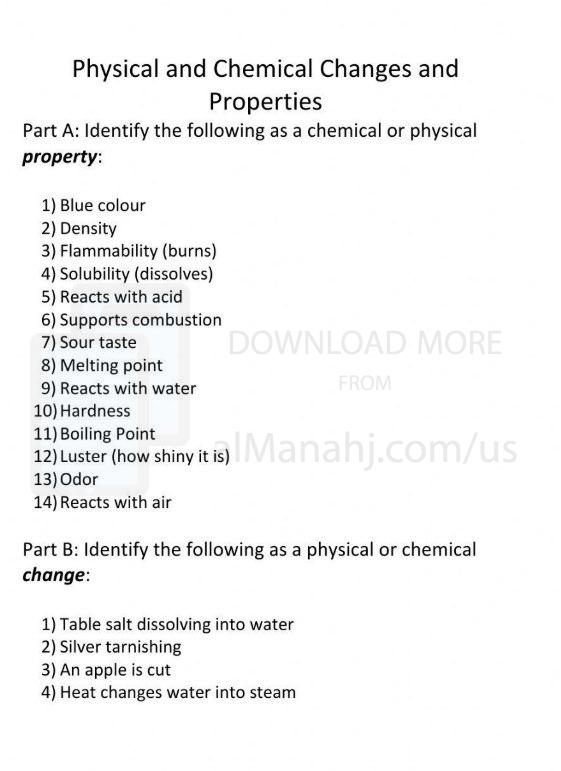| You are here: Almanahj Website ⇒ American curriculum ⇒ 10th Grade ⇒ Physics ⇒ Term 1 | ||
|---|---|---|
Worksheet about Chemical and Physical changes and properties about Properties of matter | ||
|---|---|---|
| Subject: Physics | ||
| 10th Grade | ||
| Term 1 | ||
| Year: 2023/2024 | ||
| Size: 261.8KB | ||
| Number of clicks: 86 | ||
| Publish date:November 10, 2023 | ||
| Added by: Eman | ||
| Last download date: 2024-09-05 01:23:22 | ||
| Updated by: Eman9966 on 2023-11-10 15:19:18 | By: theodor ttroisi | |
| File info: Chemical and Physical Changes and Properties of Matter Physical Properties Physical properties are characteristics of a substance that can be observed or measured without changing the identity of the substance. Some examples of physical properties include: State of matter (solid, liquid, or gas) Color Odor Density Melting point Boiling point Hardness Electrical conductivity Thermal conductivity Solubility Physical changes are changes that do not change the identity of the substance. Some examples of physical changes include: Melting ice Boiling water Cutting paper Dissolving sugar in water Bending a wire Chemical Properties Chemical properties are characteristics of a substance that describe how it interacts with other substances. Some examples of chemical properties include: Flammability Reactivity with acids and bases Reactivity with metals and non-metals Oxidizing ability Reducing ability pH Chemical changes are changes that produce a new substance with different properties than the original substance. Some examples of chemical changes include: Burning wood Rusting iron Cooking food Mixing an acid and a base Fermenting sugar Relationship between Chemical and Physical Changes and Properties Chemical and physical changes and properties are related in several ways. For example, the chemical composition of a substance determines its physical properties. For example, water and alcohol are both liquids at room temperature, but they have different physical properties because they have different chemical compositions. Chemical changes can also produce new substances with different physical properties. For example, when iron rusts, a new substance called iron oxide is formed. Iron oxide is a solid at room temperature, while iron is a metal. Examples of Chemical and Physical Changes in Everyday Life Here are some examples of chemical and physical changes that occur in everyday life: Chemical change: Burning cooking oil in a pan produces new substances, such as carbon dioxide and water. Physical change: Dissolving sugar in water produces a sugar solution, but the sugar and water molecules are still intact. Chemical change: Digesting food in our stomachs involves a series of chemical reactions that break down the food into smaller molecules that can be absorbed by our bodies. Physical change: Melting ice cream produces a liquid, but the water molecules in the ice cream are still intact. Chemical change: Mixing bleach and ammonia produces a toxic gas called chlorine gas. Conclusion Chemical and physical changes and properties are important concepts in chemistry. Understanding these concepts can help us to understand the world around us and to develop new technologies. | ||
| Downloading link Worksheet about Chemical and Physical changes and properties about Properties of matter |
|---|
|
1699617951.pdf
The file is being prepared for download
|
| File images |
|---|
 |